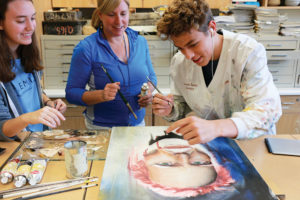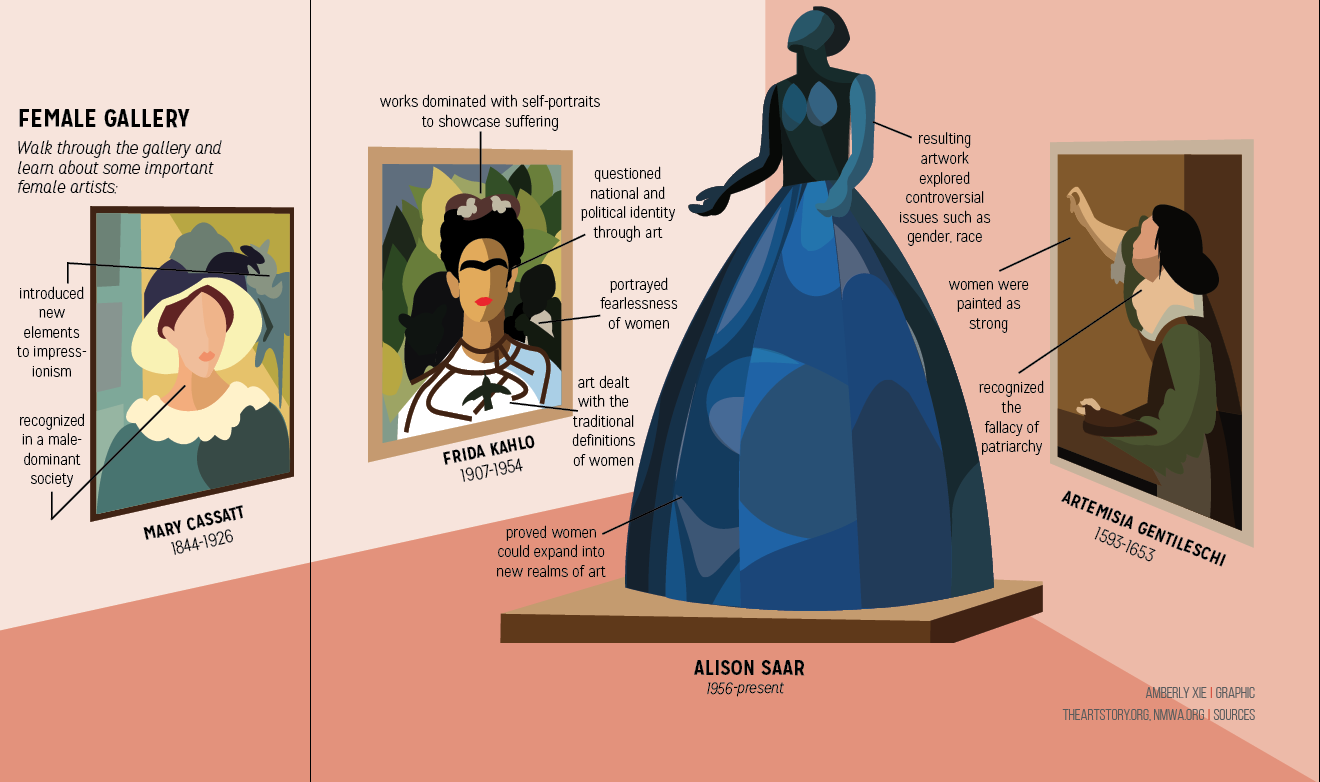To honor what would have been Frida Kahlo’s 110th birthday on July 6, hundreds of people donned floral dresses, shawls, artificial flowers and unibrows in an attempt to set the world record for the largest gathering of people dressed as Kahlo. In the years since her death, especially with the current political climate, Kahlo and other female artists have become symbols for hope and power.
In its Sept. 18 issue, Time Magazine wrote a special report on women who are changing the world. The magazine cites Cindy Sherman, the first woman to break $1 million in a photography sale, who said she noticed a significant difference between the prices of men and women artists’ works.
While taking AP Art History, senior Angelike “Kiki” Koniaris said she was shocked by the scarcity of well-known female artists. However, with the disparity of women artists, Koniaris said giving female artists a larger voice in museums has empowered society.
She said, “I think it’s because it allows women to take control of a narrative that for so long had been dominated by men.”
Koniaris is not alone. Jennifer Bubp, AP Art History teacher, said getting to honor women artists through their artwork today is inspiring because of how far they have come since she was taking collegiate art classes in the ‘90s.
Since female artists have not been represented often throughout history, the emergence of these women have influenced society with their actions and artwork.
Artists such as the Guerrilla Girls, feminist-activist artists who anonymously put up posters and stickers around the world, have brought attention to issues based on women and the lack of women in the art field. According to the National Museum of Women in the Arts website, the Guerrilla Girls said, “less than 4 percent of artists in the Modern Art section at the Metropolitan Museum of Art in New York are women, yet 76 percent of the nude artwork is female.”
Bubp said, “I think for centuries, women were seen more as craftspeople, making a quilt or doing an embroidery. Probably we all have grandmothers, great-grandmothers that made beautiful things but, in their own time, they may not have been seen as works of art.”
However, Bubp and Koniaris both said art and the number of women artists represented in art are heading in a positive direction.

Even though the situation is improving, junior Adelle Murphy said based on what she has seen, most headlines and titles are still about male artists. She said female artists “are just not as represented. They’re not taken seriously.”
This may be true, but Bubp said the art world is beginning to honor all art forms and the creative spirit.
“I think that’s something that connects us all as humans,” Bubp said, “I’m always encouraged when I see these female artists giving voice to other artists that might not otherwise be known.”
Murphy said all art has a message, and female artists often capture female empowerment within their art pieces.
She said, “They’re telling their story through their perspective of this male-dominated world.”
According to Bubp and Murphy, art is universal, connecting us together and influencing people everywhere. More specifically, Koniaris said art has the power to help people resist labels and subjugation.
“Art influences life; art influences our culture,” Koniaris said. “When women start to take that narrative, they can turn that narrative away from the subjugation of women, make us question why these values we have—about women and about gender roles and about human sexuality—are so and why does art express them.”
Bubp said art has changed substantially in the past few decades, giving more voice to females and their art, which helps to encourage and empower society.
Koniaris said, “I love looking at art and everything, but there’s some ways you can see how this became such a male-dominated power structure and all it takes sometimes is a woman to exist in that structure for it to dramatically, drastically change.”


































![AI in films like "The Brutalist" is convenient, but shouldn’t take priority [opinion]](https://hilite.org/wp-content/uploads/2025/02/catherine-cover-1200x471.jpg)









































![Review: “The Immortal Soul Salvage Yard:” A criminally underrated poetry collection [MUSE]](https://hilite.org/wp-content/uploads/2025/03/71cju6TvqmL._AC_UF10001000_QL80_.jpg)
![Review: "Dog Man" is Unapologetically Chaotic [MUSE]](https://hilite.org/wp-content/uploads/2025/03/dogman-1200x700.jpg)
![Review: "Ne Zha 2": The WeChat family reunion I didn’t know I needed [MUSE]](https://hilite.org/wp-content/uploads/2025/03/unnamed-4.png)
![Review in Print: Maripaz Villar brings a delightfully unique style to the world of WEBTOON [MUSE]](https://hilite.org/wp-content/uploads/2023/12/maripazcover-1200x960.jpg)
![Review: “The Sword of Kaigen” is a masterpiece [MUSE]](https://hilite.org/wp-content/uploads/2023/11/Screenshot-2023-11-26-201051.png)
![Review: Gateron Oil Kings, great linear switches, okay price [MUSE]](https://hilite.org/wp-content/uploads/2023/11/Screenshot-2023-11-26-200553.png)
![Review: “A Haunting in Venice” is a significant improvement from other Agatha Christie adaptations [MUSE]](https://hilite.org/wp-content/uploads/2023/11/e7ee2938a6d422669771bce6d8088521.jpg)
![Review: A Thanksgiving story from elementary school, still just as interesting [MUSE]](https://hilite.org/wp-content/uploads/2023/11/Screenshot-2023-11-26-195514-987x1200.png)
![Review: "When I Fly Towards You", cute, uplifting youth drama [MUSE]](https://hilite.org/wp-content/uploads/2023/09/When-I-Fly-Towards-You-Chinese-drama.png)
![Postcards from Muse: Hawaii Travel Diary [MUSE]](https://hilite.org/wp-content/uploads/2023/09/My-project-1-1200x1200.jpg)
![Review: "Ladybug & Cat Noir: The Movie," departure from original show [MUSE]](https://hilite.org/wp-content/uploads/2023/09/Ladybug__Cat_Noir_-_The_Movie_poster.jpg)
![Review in Print: "Hidden Love" is the cute, uplifting drama everyone needs [MUSE]](https://hilite.org/wp-content/uploads/2023/09/hiddenlovecover-e1693597208225-1030x1200.png)
![Review in Print: "Heartstopper" is the heartwarming queer romance we all need [MUSE]](https://hilite.org/wp-content/uploads/2023/08/museheartstoppercover-1200x654.png)




